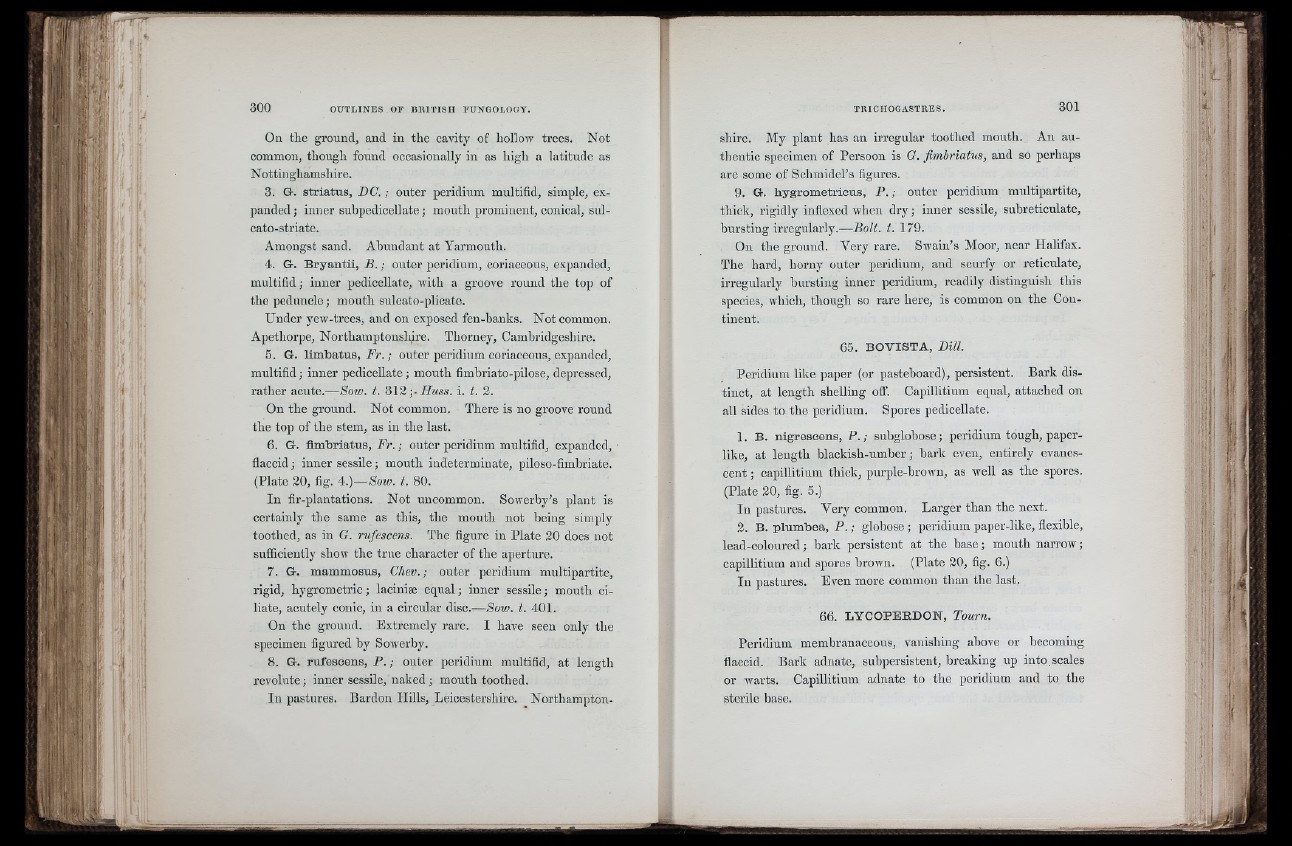
On the ground, and in the cavity of hollow trees. Not
common, though found occasionally in as high a latitude as
Nottinghamshire.
3. G. striatus, DC. ; outer peridium multifid, simple, e.x-
panded ; inner subpediccllate ; mouth prominent, conical, sulcato
striate.
Amongst sand. Abundant at Yarmouth.
4. G. Bryantii, B. ; outer peridium, coriaceous, e.xpanded,
multifid ; inner pedicellate, with a groove round the top of
the peduncle ; mouth sulcato-plicate.
Under yew-trees, and on exposed fen-banks. Not common.
Apethorpe, Northamptonslpre. Thorney, Cambridgeshire.
5. G. limbatus, Fr. ; outer peridium coriaceous, expanded,
multifid; inner pedicellate; mouth fimbriato-pilose, depressed,
rather acute.—Sow. t. 312 ;■ Fluss. i. t. 2.
On the ground. Not common. There is no groove round
the top of the stem, as in the last.
6. G. fimbriatus, Fr. ; outer peridium multifid, expanded, ■
flaccid ; inner sessile ; mouth indeterminate, piloso-fimbriate.
(Plate 20, fig. 4.)—Sow. t. 80.
In fir-plantations. Not uncommon. Sowerby’s plant is
certainly the same as this, the mouth not being simply
toothed, as in C. rufescens. The figure in Plate 20 does not
sufficiently show the true character of the aperture.
7. G. mammosns, Chev. ; outer peridium multipartite,
rigid, hygrométrie ; laciniæ equal ; inner sessile ; mouth ci-
liate, acutely conic, in a circular disc.—Sow. t. 401.
On the ground. Extremely rare. I have seen only the
specimen figured by Sowerby.
8. G. rufesoens, P. ; outer peridium multifid, at length
revolute ; inner sessile, naked ; mouth toothed.
In pastures. Bardon Hills, Leicestershire. Northamptonshire.
My plant has an irregular toothed mouth. An authentic
specimen of Persoon is C. fimbriatus, and so perhaps
are some of Schmidel’s figures.
9. G. bygrometricus, P . ; outer peridium multipartite,
thick, rigidly inflexed when dry; inner sessile, subreticulate,
bursting irregularly.—Bolt. t. 179.
On the ground. Very rare. Swain’s Moor, near Halifax.
The hard, horny outer peridium, and scurfy or reticulate,
irregularly bursting inner peridium, readily distinguish this
species, which, though so rare here, is common on the Continent.
65. BOVISTA, Dill.
Peridium like paper (or pasteboard), persistent. Bark distinct,
at length shelling off. Capillitium equal, attached on
all sides to the peridium. Spores pedicellate.
1. B. nigrescens, P .; subglobose; peridium tough, paperlike,
at length blackish-umber; hark even, entirely evanescent
; capillitium thick, purple-brown, as well as the spores.
(Plate 20, fig. 5.)
In pastures. Very common. Larger than the next.
2. B. plúmbea, P . ; globose ; peridium paper-like, flexible,
lead-coloured; bark persistent at the base; mouth narrow;
capillitium and spores brown. (Plate 20, fig. 6.)
In pastures. Even more common than the last.
66. LYCOPERDON, Tourn.
Peridium membranaceous, vanishing above or becoming
flaccid. Bark adnate, subpersistent, breaking np into,scales
or warts. Capillitium adnate to the peridium and to the
sterile base.
:i 'I
F'
l i i l i
l ’\
; I ;